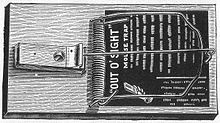Build a better mousetrap, and the world will beat a path to your door

"Build a better mousetrap, and the world will beat a path to your door" is a metaphor about the power of innovation. It originated, in a somewhat different form, with Ralph Waldo Emerson.[1][2] The epigram as known today, which specifies "mousetrap", probably also originated with Emerson, although the evidence for this is indirect.[3]
Origin
[edit]
In February 1855, Emerson wrote in his journal, under the heading "Common Fame":
If a man has good corn or wood, or boards, or pigs, to sell, or can make better chairs or knives, crucibles or church organs, than anybody else, you will find a broad hard-beaten road to his house, though it be in the woods.[4]
In May 1882, a month after his death, the following quotation was attributed (with no date or source) to Emerson by The Cincinnati Enquirer under the heading "The Value of Good Work":
If a man can write a better book, preach a better sermon or make a better mouse-trap than his neighbors, though he builds his house in the woods, the world will make a beaten path to his door.
Researchers believe it likely that Emerson used a modified version of the theme from his journal in a lecture given at some point after 1855, with the word "mouse-trap" inserted in place of one of the other example products.[1][3]
Meaning
[edit]The phrase has become an axiom for the power of successful innovation.[5] Statistics suggest that it is frequently taken literally, with more than 4,400 patents issued by the United States Patent and Trademark Office for new mousetraps, with thousands more unsuccessful applicants, making them the "most frequently invented device in U.S. history".[5] The popular modern snap-trap version of the mousetrap was invented by William C. Hooker in 1894 and improved by John Mast in 1899, during the period that the "better-mousetrap" epigram was becoming popular.[6]
Notes
[edit]- ^ a b Shapiro, Fred R. (2006). Yale Book of Quotations. New Haven: Yale University Press. pp. 244–245. ISBN 978-0-300-10798-2.
- ^ Lienhard, John H. (18 September 2003). Inventing Modern: Growing Up with X-Rays, Skyscrapers, and Tailfins. Oxford University Press. p. 204. ISBN 978-0-19-803636-4.
- ^ a b "If You Build a Better Mousetrap the World Will Beat a Path to Your Door". QuoteInvestigator.com. March 24, 2015. Retrieved February 26, 2024.
- ^ Emerson, Ralph Waldo; Emerson, Edward; Forbes, Waldo Emerson (1909–14). Journals of Ralph Waldo Emerson: With Annotations. Riverside Press.
- ^ a b Kassinger, Ruth (2002). Build a Better Mousetrap. Hoboken, NJ: John Wiley & Sons. p. 128. ISBN 0-471-39538-2.
- ^ "Drummond D., Brandt C & Koch J. (2002)". Retrieved 12 May 2014.
References
[edit]- American Heritage Magazine, "A Better Mousetrap", 1996, Volume 47, Issue 6.
